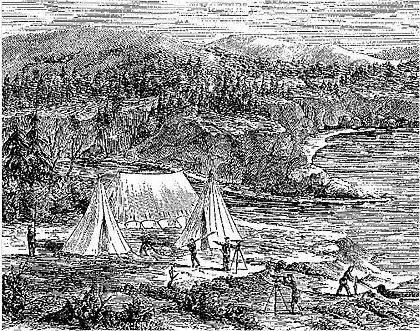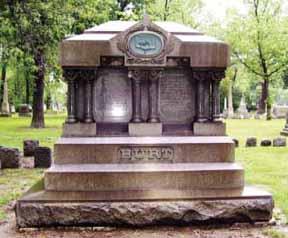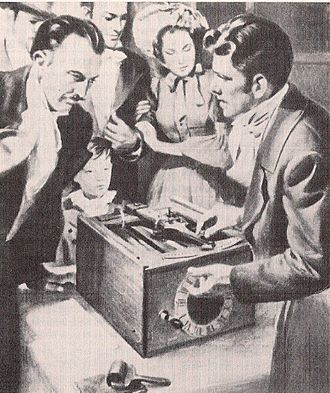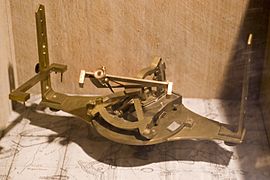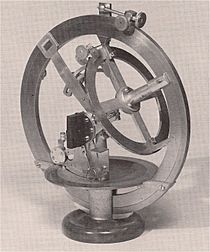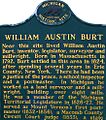William Austin Burt facts for kids
Quick facts for kids
William Austin Burt
|
|
|---|---|
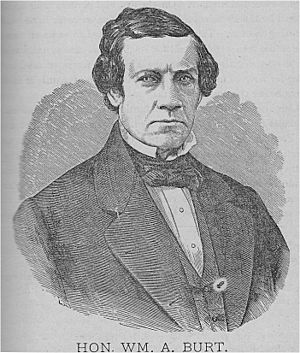
sketch, before 1873
|
|
| Born |
William Austin Burt
June 13, 1792 Petersham, Massachusetts, U.S.
|
| Died | August 18, 1858 (aged 66) Detroit, Michigan, U.S.
|
| Resting place | Elmwood Cemetery, Detroit, Michigan, U.S. |
| Occupation | Surveyor |
| Employer | United States government |
| Known for |
|
| Title | Hon. Wm. A. Burt |
| Political party | Jeffersonian Republican |
| Spouse(s) | Phoebe Cole |
| Children | 5 sons |
| Signature | |
William Austin Burt (born June 13, 1792 – died August 18, 1858) was an amazing American inventor, scientist, and surveyor. He also served as a lawmaker, judge, and postmaster. Burt was known for his very accurate surveying work on public lands. He trained many young men to become professional surveyors.
Burt surveyed land boundaries in Michigan, Wisconsin, Minnesota, and Iowa starting in 1833. His five sons also became government surveyors, following in his footsteps. He helped survey and build the Sault Ste. Marie Canal. This canal uses special water locks to help ships travel past the fast-moving waters on the St. Marys River.
William Burt invented several important tools. His 1829 "typographer" was the first typing machine built and patented in America. Sadly, the original was lost in a fire. A model of it was later made for the 1893 World's Fair and is now at the Smithsonian Institution.
Burt also invented the solar compass. He created it because regular magnetic compasses didn't work well in areas with lots of iron. He found this problem in Marquette County, Michigan, where huge iron deposits made compass needles spin wildly. His solar compass used the sun to find directions accurately.
He also invented the equatorial sextant for ships. This tool helped sailors know their exact location at sea. It used the sun as a guide, just like his solar compass.
Contents
About William Burt
His Early Life
William Burt was the fifth of eight children. His family came from Scotland and England. His ancestor, Richard Burt, moved to America from England around 1638. William was born on June 13, 1792, on his parents' farm in Petersham, Massachusetts. When he was six, his family moved to New York.
Burt only went to school for about six weeks in his whole childhood. He learned a lot at home from his mother and a neighbor named Thomas Brown, who was a college instructor from Scotland. William loved to learn. When he was about twelve, he even built a special desk so he could read while making shingles!
When he was about fifteen, his father gave him a book about navigation. William studied it on his own, dreaming of becoming a boat captain. He learned how to figure out a ship's location and even built his own tool called a quadrant. With it, he accurately found the latitude of his father's house, even though he had never seen a real navigation tool before! He was also very interested in astronomy.
From a young age, William wanted to do something useful for people. He studied math, science, and astronomy whenever he could find books. These subjects interested him his whole life.
Becoming a Surveyor
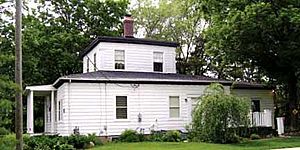
William's mother didn't want him to be a ship captain because her own father had been lost at sea. So, Burt decided to use his science and math skills in another way. In 1810, at age eighteen, he bought a broken surveying compass. He fixed it and started surveying land near his father's farm in New York.
In 1812, he joined the United States army, which paused his surveying work. After the war, he held several public jobs in New York, like justice of the peace and postmaster. In 1817, when he was 25, Burt traveled for 81 days to the far west. He walked, used small boats, and rode horses. He visited cities like Pittsburgh, Cincinnati, and St. Louis. These trips helped him prepare to become a government surveyor.
In 1824, Burt moved to Michigan. He met important people who encouraged him to live in Detroit. There, he built sawmills and gristmills. In 1825, he traveled to an area that is now Port Huron, Michigan. He built mills there for a businessman named Robert Smart.
Burt loved country life for his family. In 1833, at age 41, he became a deputy surveyor for the U.S. government. Three of his sons, John, Alvin, and Austin, were old enough to help him. Within 18 years, all five of his sons became government surveyors. He also trained many other young men in surveying techniques in Michigan, Wisconsin, and Iowa. He surveyed the boundaries for cities like Milwaukee, Wisconsin, Davenport, Iowa, and Dubuque, Iowa.
Burt used his solar compass for the first time in 1836. His son, Alvin, even used it to survey the boundary between Iowa and Minnesota. William Burt was the first U.S. surveyor in the Upper Peninsula of Michigan.
In 1844, Burt discovered the Marquette Iron Range in Michigan's Upper Peninsula. He worked with geologist Dr. Douglass Houghton on iron ore samples. Burt noticed that regular magnetic compasses didn't work there because of the huge iron deposits. The compass needles would spin wildly! He realized his solar compass was perfect for this area. It used the sun, so it wasn't affected by the iron. This discovery was very important, as the Great Lakes iron range later produced 80 percent of the nation's iron ore.
Burt's solar compass was so accurate that it became the standard tool for government land surveys across the western United States. It saved a lot of money by preventing mistakes in property lines.
Family and Public Service
In 1812, Burt met Phoebe Cole. They married on July 4, 1813, and had five sons: John, Alvin, Austin, Wells, and William.
Burt was a member of the Michigan Legislature. He helped create the laws for building the Sault Ste. Marie Canal. He surveyed the canal's route in 1852. This canal helps ships travel between Canada and the United States, connecting the Great Lakes to the Atlantic Ocean.
He served as Mount Vernon's first postmaster from 1832 to 1856. He was also a judge and a state lawmaker. In 1847, he helped set the exact boundary between Michigan and Wisconsin. People often called him "Judge Burt."
William Burt received awards for his inventions. Prince Albert, Queen Victoria's husband, gave him a gold medal at the 1851 London's World Fair for his equatorial sextant.
Later Life and Legacy
Burt moved to Detroit in 1857. He died there on August 18, 1858, at age 66. He was teaching a class of sea captains how to use his equatorial sextant when he passed away. He is buried in the Burt Family lot at the Elmwood Cemetery.
William Burt is remembered with a historical plaque near his home in Michigan. Burt Lake and Burt Township in Michigan are named after him. The University of Michigan received his original 1858 Equatorial Sextant in 1909.
Burt's Inventions
William Burt created several important inventions. He is sometimes called the "father of the typewriter." He also invented the first working solar compass and the equatorial sextant.
The Typographer
Burt's "typographer," patented in 1829, was an early version of today's typewriter. It was the first working typing machine patented in America. The original patent was signed by President Andrew Jackson. The model of the patent was lost in a fire in 1836. Burt chose the name "typographer" for his invention. Later, the word became "type-writer" and then simply "typewriter."
The typographer was a wooden box with a lever. You would select a letter, press the lever, and it would print onto paper. It could print both capital and small letters. While Burt's machine typed clearly, it didn't become popular during his lifetime. There wasn't a big need for such a machine yet.
In 1893, Burt's great-grandson, Austin Burt, built a working model of the typographer for the Chicago World's Fair. He used a copy of the original patent to build it. This model is now at the Smithsonian Institution.
The Solar Compass
William Burt was a very active surveyor. His surveys helped discover rich iron and copper deposits in Michigan. This made Michigan a very important mining area in the United States.
Burt invented his solar compass in 1835. This tool solved a big problem for surveyors. Regular magnetic compasses didn't work well in areas with lots of iron ore because the iron interfered with the compass needle. Burt's solar compass used the sun's position to find true north and south, so it was always accurate.
Because of its accuracy, the solar compass became the standard tool for government land surveys across the western United States. It was used until the Global Positioning System (GPS) became available much later.
The Equatorial Sextant
Burt designed and invented the Equatorial Sextant to help ships at sea find their exact location quickly. He was inspired to create it during a trip back from England. This tool could figure out a ship's direction, height above the horizon, time, and position with just one observation.
Burt used the same ideas from his solar compass to make this tool. It used the sun as a reference point. Other compasses at the time relied on the Earth's magnetic field, which could be unreliable and cause ships to go off course. Burt's sextant was not affected by magnetism or iron, helping ships stay on their true path.
Images for kids


